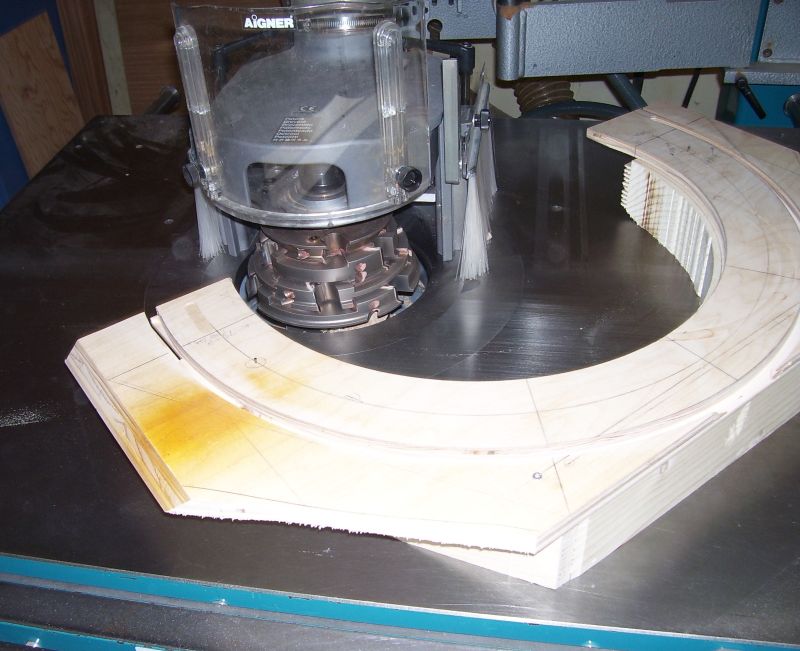Slowing Planer Feed Rate
Advice and cautions on ways to slow down the feed rate of a planer. November 27, 2007
Question
I have a 20" Bridgewood planer that is single speed with a 26 fpm feed rate. I'd like to slow down the feed rate slightly to reduce tearout. I talked with Wilke Machinery (distributor for Bridgewood), and they don't have any modification kit.
Has anyone changed the pulley size for the infeed/outfeed roller and belt to slow down the feed rate? Any idea on how much smaller pulley I would need to go from 26 fpm to something in the 18 fpm range? My other thought was to install a Byrd Shelix cutterhead to get more cuts per inch, but I've been tentative after reading the posts regarding ridges in face planed stock.
Forum Responses
(Solid Wood Machining Forum)
From contributor L:
Make your big pulley 31% bigger or your small pulley 31% smaller. Or make them 15% bigger and smaller respectively. You didn't give sizes, so this is the only way I can relay the info to you.
From contributor R:
Consider a standard helical head. I think the scallop issue is way out of proportion for the Byrd. You still have to sand anyway.
18 to 26 would be a pulley 1/3 approximate difference in size. It's been awhile since I've seen the insides of a Bridgwood. Used to tune up a friend's 16" Bridgewood planer. Separate motor for the feed, I vaguely recall?! Then it would be doable. If it is three phase, you could put a VFD and get even more speed control. Another option is to increase the head speed slightly. Care must be exercised with this option.
From contributor J:
I've got the Bridgewood 20" with their insert cutterhead (not Shelix) on it, and have to say I am very happy with the cut quality. I've also got the variable speed, but have yet to need it. I plane mostly maple and have almost no tearout.
From contributor S:
Try an adjustable feed drive such as "reeves." These come with a hand-wheel adjustment and can give a 10x1 speed adjustment range. These can be picked up on eBay or at scrapyards from old conveyor systems or pumps.
From Professor Gene Wengert, Sawing and Drying Forum technical advisor:
Make sure that if you go with a speed reducer, you *do not* reduce the cutter head speed as well. Chipped grain can be reduced by taking smaller cuts, depth-wise. It also can be reduced by decreasing the rake angle. Avoiding over-dried lumber is also a key.
From contributor T:
An electrical inverter would do the trick. Then you could set any speed on the feed speed and not have to rebuild your planer. But as Gene said, you would want to make sure your feed motor and cutter head motor are not one in the same.
From contributor L:
An inverter will only work if his planer drive motor is 3 phase.
From the original questioner:
Thanks for the input. The planer is single phase and the motor runs both the cutterhead and drive. My tearout is noticeable when I'm running my face frame material through ganged together on its side. Face planing is okay. I think I'm going to install a Byrd head and plan B will be to install a separate drive motor for the feed if I'm still getting tearout.
From Professor Gene Wengert, Sawing and Drying Forum technical advisor:
You can also eliminate chipped grain by reversing the wood direction, end for end; that is, feed the piece the other direction. Chipped grain occurs when you are planing against the grain, so reversing the piece means you are now planing with the grain. This reversal is usually not practical in a production situation, however.
From contributor S:
Woodmaster Tools makes a planer that has these features you want, rather than reinvent the wheel. Spiral cutter head option, adjustable (separate) feed drive motor, and the 25 inch capacity.
Otherwise you could pick up an old moulder such as a Mattison 276 with an adjustable feed drive built in. This model can be distinguished by the large square pulley cover on the back and a numbered hand crank below the feed table.
From contributor G:
Remove the gear cover, install a dc variable speed drive to the feed roller gear. (Involves removing a chain and some fabrication issues, but if you feel you've got to do it, it can be done.)
From contributor N:
If your main problem is with quartered grain on face frame stock, get it milled by somebody with a moulder. It's fast for them to do, and it doesn't cost much either. You'd be amazed how fast a Weinig can spit that stuff out, and it's more consistent and cleaner.
From contributor A:
I put a small adjustable rate dc motor for feeding on my cheap 20" Grizzly as Part A of a two part improvement. Part B was a Byrd head. In retrospect, Part A was unnecessary, though the slow speed option is nice for particularly gnarly grain, or just for proper work flow when handling many small pieces, which I do a lot. Mostly I use my top feed speed, about 23 FPM, and I should have made it faster yet. The Byrd head will have very little tear-out even at 26 FPM, and I'm sure your Bridgewwod is a much better machine than mine.
From the original questioner:
Update: Like contributor A, I installed the Byrd head and have decided that I don't need to slow down the feed rate. Thanks for all the responses.
